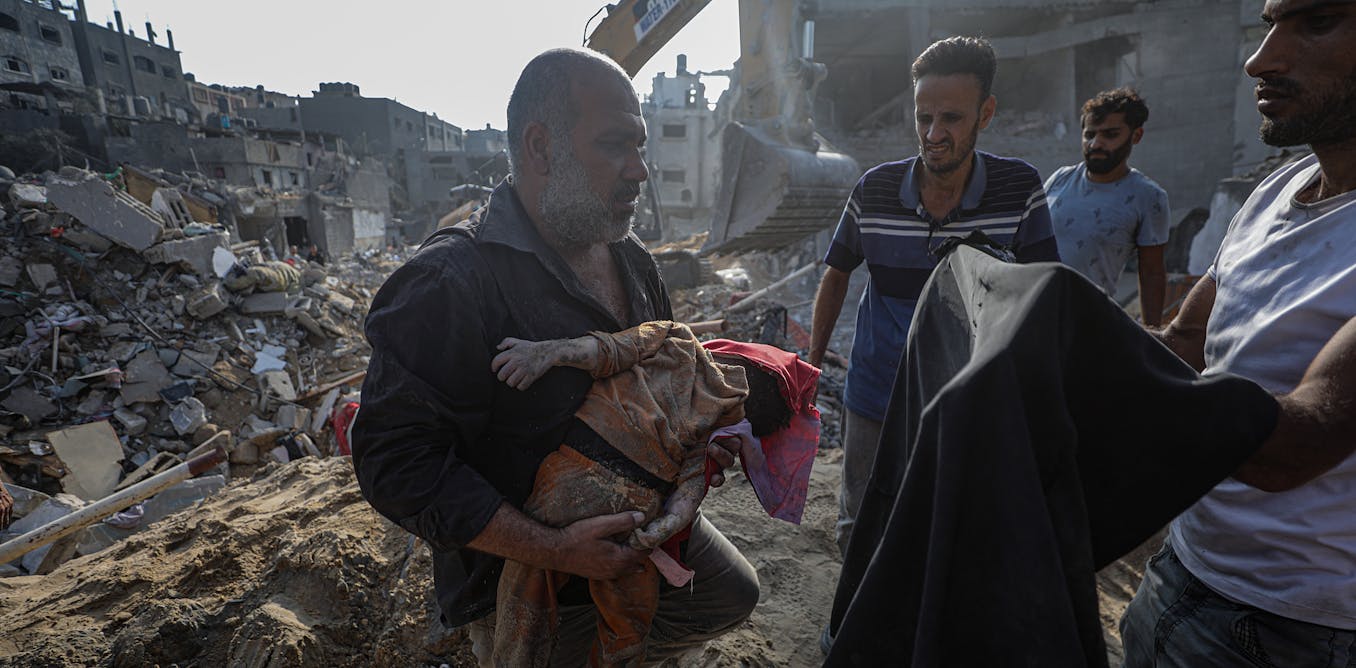As Israel’s air campaign in Gaza enters its sixth month after Hamas’s terrorist attacks on October 7, it has been described by experts as one of the most relentless and deadliest campaigns in recent history. It is also one of the first being coordinated, in part, by algorithms.
Artificial intelligence (AI) is being used to assist with everything from identifying and prioritising targets to assigning the weapons to be used against those targets.
Academic commentators have long focused on the potential of algorithms in war to highlight how they will increase the speed and scale of fighting. But as recent revelations show, algorithms are now being employed at a large scale and in densely populated urban contexts.
This includes the conflicts in Gaza and Ukraine, but also in Yemen, Iraq and Syria, where the US is experimenting with algorithms to target potential terrorists through Project Maven.
Amid this acceleration, it is crucial to take a careful look at what the use of AI in warfare actually means. It is important to do so, not from the perspective of those in power, but from those officers executing it, and those civilians undergoing its violent effects in Gaza.
This focus highlights the limits of keeping a human in the loop as a failsafe and central response to the use of AI in war. As AI-enabled targeting becomes increasingly computerised, the speed of targeting accelerates, human oversight diminishes and the scale of civilian harm increases.
Speed of targeting
Reports by Israeli publications +927 Magazine and Local Call give us a glimpse into the experience of 13 Israeli officials working with three AI-enabled decision-making systems in Gaza called “Gospel”, “Lavender” and “Where’s Daddy?”.
These systems are reportedly trained to recognise features that are believed to characterise people associated with the military arm of Hamas. These features include membership of the same WhatsApp group as a known militant, changing cell phones every few months, or changing addresses frequently.
The systems are then supposedly tasked with analysing data collected on Gaza’s 2.3 million residents through mass surveillance. Based on the predetermined features, the systems predict the likelihood that a person is a member of Hamas (Lavender), that a building houses such a person (Gospel), or that such a person has entered their home (Where’s Daddy?).
In the investigative reports named above, intelligence officers explained how Gospel helped them go “from 50 targets per year” to “100 targets in one day” – and that, at its peak, Lavender managed to “generate 37,000 people as potential human targets”. They also reflected on how using AI cuts down deliberation time: “I would invest 20 seconds for each target at this stage … I had zero added value as a human … it saved a lot of time.”
They justified this lack of human oversight in light of a manual check the Israel Defense Forces (IDF) ran on a sample of several hundred targets generated by Lavender in the first weeks of the Gaza conflict, through which a 90% accuracy rate was reportedly established. While details of this manual check are likely to remain classified, a 10% inaccuracy rate for a system used to make 37,000 life-and-death decisions will inherently result in devastatingly destructive realities.
But importantly, any accuracy rate number that sounds reasonably high makes it more likely that algorithmic targeting will be relied on as it allows trust to be delegated to the AI system. As one IDF officer told +927 magazine: “Because of the scope and magnitude, the protocol was that even if you don’t know for sure that the machine is right, you know that statistically it’s fine. So you go for it.”
The IDF denied these revelations in an official statement to The Guardian. A spokesperson said that while the IDF does use “information management tools […] in order to help intelligence analysts to gather and optimally analyse the intelligence, obtained from a variety of sources, it does not use an AI system that identifies terrorist operatives”.
The Guardian has since, however, published a video of a senior official of the Israeli elite intelligence Unit 8200 talking last year about the use of machine learning “magic powder” to help identify Hamas targets in Gaza. The newspaper has also confirmed that the commander of the same unit wrote in 2021, under a pseudonym, that such AI technologies would resolve the “human bottleneck for both locating the new targets and decision-making to approve the targets”.
Scale of civilian harm
AI accelerates the speed of warfare in terms of the number of targets produced and the time to decide on them. While these systems inherently decrease the ability of humans to control the validity of computer-generated targets, they simultaneously make these decisions appear more objective and statistically correct due to the value that we generally ascribe to computer-based systems and their outcome.
This allows for the further normalisation of machine-directed killing, amounting to more violence, not less.
While media reports often focus on the number of casualties, body counts – similar to computer-generated targets – have the tendency to present victims as objects that can be counted. This reinforces a very sterile image of war. It glosses over the reality of more than 34,000 people dead, 766,000 injured and the destruction of or damage to 60% of Gaza’s buildings and the displaced persons, the lack of access to electricity, food, water and medicine.
It fails to emphasise the horrific stories of how these things tend to compound each other. For example, one civilian, Shorouk al-Rantisi, was reportedly found under the rubble after an airstrike on Jabalia refugee camp and had to wait 12 days to be operated on without painkillers and now resides in another refugee camp with no running water to tend to her wounds.
Aside from increasing the speed of targeting and therefore exacerbating the predictable patterns of civilian harm in urban warfare, algorithmic warfare is likely to compound harm in new and under-researched ways. First, as civilians flee their destroyed homes, they frequently change addresses or give their phones to loved ones.
Such survival behaviour corresponds to what the reports on Lavender say the AI system has been programmed to identify as likely association with Hamas. These civilians, thereby unknowingly, make themselves suspect for lethal targeting.
Beyond targeting, these AI-enabled systems also inform additional forms of violence. An illustrative story is that of the fleeing poet Mosab Abu Toha, who was allegedly arrested and tortured at a military checkpoint. It was ultimately reported by the New York Times that he, along with hundreds of other Palestinians, was wrongfully identified as Hamas by the IDF’s use of AI facial recognition and Google photos.
CTK Photo/Pavel Nemecek
Over and beyond the deaths, injuries and destruction, these are the compounding effects of algorithmic warfare. It becomes a psychic imprisonment where people know they are under constant surveillance, yet do not know which behavioural or physical “features” will be acted on by the machine.
From our work as analysts of the use of AI in warfare, it is apparent that our focus should not solely be on the technical prowess of AI systems or the figure of the human-in-the-loop as a failsafe. We must also consider these systems’ ability to alter the human-machine-human interactions, where those executing algorithmic violence are merely rubber stamping the output generated by the AI system, and those undergoing the violence are dehumanised in unprecedented ways.
The post “artificial intelligence is changing the speed of targeting and scale of civilian harm in unprecedented ways” by Lauren Gould, Assistant Professor, Conflict Studies, Utrecht University was published on 04/23/2024 by theconversation.com

The post “How Artificial Intelligence is Transforming Targeting Speed and Civilian Harm Scale” – GretAi News” by GretAi was published on 04/23/2024 by news.gretai.com





































